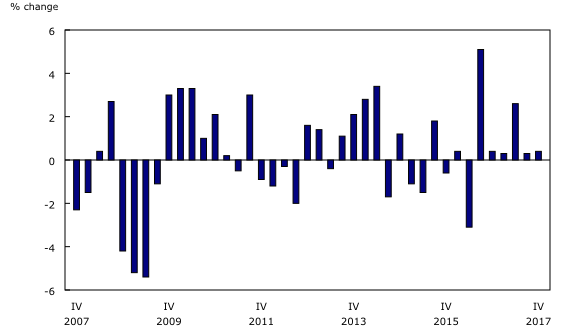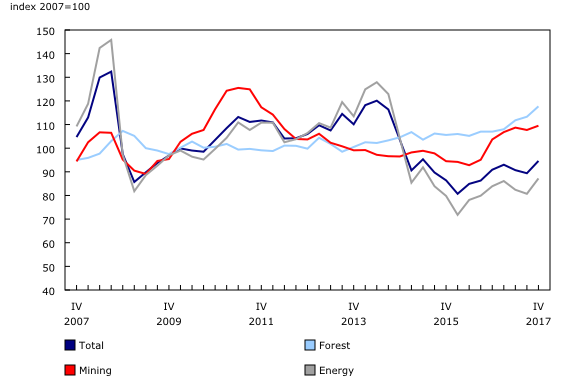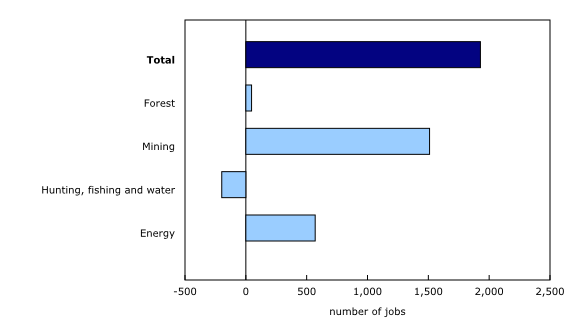Natural resource indicators, fourth quarter 2017
Archived Content
Information identified as archived is provided for reference, research or recordkeeping purposes. It is not subject to the Government of Canada Web Standards and has not been altered or updated since it was archived. Please "contact us" to request a format other than those available.
Released: 2018-03-27
Increase in volume of natural resource production
Real natural resource gross domestic product (GDP), or the volume of economic activity attributable to natural resources, increased 0.4% in the fourth quarter, following growth of 0.3% in the third quarter. In comparison, real GDP for the total economy grew 0.4% in the fourth quarter.
Energy, the largest subsector, increased 0.4% due to growth in crude oil (+1.6%) and natural gas (+0.9%) extraction. The forest subsector was up 2.3% as primary sawmill and wood products (+5.1%) showed strong growth. Strong demand from the housing industry in Canada and the United States fueled the industry, despite recent US tariffs on softwood lumber.
Minerals and mining real GDP decreased 0.2% in the fourth quarter. The decline stemmed from minerals and mining extraction (-1.0%) and related services (-5.4%). Weak demand for uranium, potash and coal led to layoffs and temporary plant shutdowns in this subsector.
Natural resource activity totalled $224 billion (nominal terms, at annual rates) in the fourth quarter, accounting for 11.0% of Canada's GDP. This was its highest share since the second quarter of 2015, and coincided with large price increases in the energy subsector.
Natural resource prices rise
Natural resource prices rose 5.8% in the fourth quarter, with prices up in most subsectors. The global rebound in oil prices led to big gains in the price of crude oil (+16.2%) and refined petroleum products (+10.2%). As a whole, prices increased 8.1% in the energy subsector.
Prices were up 3.9% in the forest subsector, led by a 9.9% increase in products related to extraction. Mining and mineral prices rose 1.7%.
Export volumes down
Real natural resource exports decreased 1.6% in the fourth quarter, following a 2.0% decrease in the third quarter. Energy exports fell 2.9% as shipping bottlenecks resulted in a 4.9% decline in crude oil exports. Minerals and mining exports fell 1.4% with a large decline in coal exports (-13.3%). Forest exports were up 4.1% as a drop in extractive products (logs and pulpwood) was more than offset by an increase in primary manufactured products (lumber and other sawmill products).
Real natural resource imports saw little change (+0.1%) in the fourth quarter. The energy subsector fell 0.7%, with a large decline in natural gas imports (-24.5%) being partially offset by a 5.2% increase in crude oil imports.
Employment increases in the fourth quarter
Employment in the natural resources sector increased 0.3% in the fourth quarter, compared with a 0.9% increase in the third quarter. The largest growth came in the minerals and mining subsector, where 1,500 jobs were added (+0.7%), coinciding with the commencement of production at two gold mines.
The energy subsector saw an increase of nearly 600 jobs (+0.2%), while the forest subsector saw little change. The hunting, fishing and water subsector lost 200 jobs in the quarter (-0.8%).
Downstream activities increase
Secondary and tertiary processing for the forest and the minerals and mining subsectors are identified in the natural resource indicators for analytical purposes. An additional 1.6% of Canadian GDP is attributable to these downstream activities.
Real GDP of these additional downstream activities increased 2.4% in the fourth quarter with the largest gains in the downstream forest subsector (+3.8%), specifically secondary paper products (+6.2%).
Energy sector drives growth in 2017
The real GDP of the natural resources sector increased by 4.6% in 2017, its highest annual growth rate since 2014. In comparison, real GDP for the total economy grew at 3.0%. The strong growth in the natural resources sector was largely attributable to the energy subsector (+6.1%), which represented about 70% of the real natural resources GDP in 2017. Growth was evidenced in many components of this subsector, notably related services (+8.6%) and natural gas extraction (+7.2%).
Natural resources prices increased 7.2% in 2017. Minerals and mining subsector prices led the way (+12.2%), driven by higher coal (+91.9%) and metallic mineral (+13.6%) prices. Energy prices grew 7.1%, with crude oil (+16.9%), refined petroleum product (+13.4%) and natural gas (+10.0%) prices causing the rapid growth.
Real natural resource exports were up 6.2% in 2017. The majority of that increase came from the energy subsector (+10.0%), where refined petroleum product exports were up 27.9% over 2016.
Employment in the natural resources industry was up 1.4% in 2017. The minerals and mining subsector led the increase, adding 6,100 jobs (+3.1%). The energy subsector added 3,700 jobs (+1.4%), while the forest subsector (-0.4%) and the hunting, fishing and water subsector (-2.1%) both saw a decrease of approximately 500 jobs.
Note to readers
The natural resource indicators provide quarterly indicators for the main aggregates in the Natural Resource Satellite Account (NRSA), namely, nominal and real gross domestic product, output, real exports and imports, and employment. The estimates from this account are directly comparable to the estimates found in the Canadian System of Macroeconomic Accounts.
The energy subsector accounts for approximately two-thirds of the Canadian natural resource sector, while the mining subsector accounts for just over 20%. The forest (8%) and hunting, fishing and water (4%) subsectors account for the rest.
Core natural resources: The NRSA defines natural resource activities as those which result in goods and services originating from naturally-occurring assets used in economic activity, as well as their initial processing (primary manufacturing).
Downstream activities: Although not part of the core account, natural resources have important downstream effects on other sectors. In general, this production uses a large portion of primary manufactured products as inputs.
Next release
Data on natural resource indicators for the first quarter will be released on June 27.
Products
The Latest Developments in the Canadian Economic Accounts (13-605-X) is available.
The User Guide: Canadian System of Macroeconomic Accounts (13-606-G) is available.
The Methodological Guide: Canadian System of Macroeconomic Accounts (13-607-X) is available.
The System of Macroeconomic Accounts module features an up-to-date portrait of national and provincial economies and their structure.
Contact information
For more information, or to enquire about the concepts, methods or data quality of this release, contact us (toll-free 1-800-263-1136; 514-283-8300; STATCAN.infostats-infostats.STATCAN@canada.ca) or Media Relations (613-951-4636; STATCAN.mediahotline-ligneinfomedias.STATCAN@canada.ca).
- Date modified:





